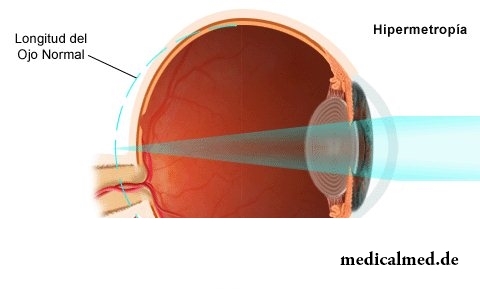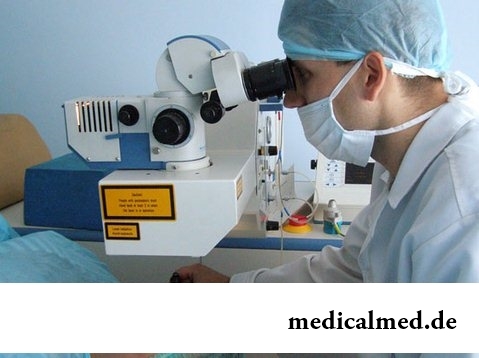





Far-sightedness
General characteristic of a disease
 Far-sightedness or hypermetropia is an ophthalmologic disease with the broken visual acuity at a view of the objects located close. However at far-sightedness of high degree of people sees distorted the objects which are from it as at distance of 20-30 cm, and further 10 m.
Far-sightedness or hypermetropia is an ophthalmologic disease with the broken visual acuity at a view of the objects located close. However at far-sightedness of high degree of people sees distorted the objects which are from it as at distance of 20-30 cm, and further 10 m.
The disease leads to a systematic overstrain of eye muscles therefore far-sighted people quite often suffer from a headache and visual overfatigue. Every second inhabitant of Earth suffers from far-sightedness of this or that degree on average approximately 30 years are more senior. Aged about one year and after 50 years far-sightedness – natural state of the visual device of the person.
Far-sightedness reasons
Normal at well seeing person the image is focused on a retina, but not on the plane behind it as it occurs at far-sightedness. As the reason of an abnormal refraction of eyes the small size of an eyeglobe on a perednezadny axis most often acts. For this reason at newborns far-sightedness is the natural physiological phenomenon which in most cases independently passes with age.
One more possible reason of far-sightedness – disturbance of accommodation of a crystalline lens, its inability it is correct to change curvature. This disturbance leads to a disease of other type – age far-sightedness or a presbyopy. The person is more senior, the it is worse akkomodatsionny opportunities of his eyes, and the degradation of the image of the objects located close becomes stronger.
Types of far-sightedness
Except natural physiological far-sightedness children of infantile age can have an inborn disease. It is about those cases when sight at the child independently does not return to normal over time. Not only the small size of an eyeglobe, but also the weak inborn refracting force of a crystalline lens or cornea can serve as the reason of far-sightedness of this form.
At inborn far-sightedness children with coefficient higher than 3.0 dioptries have a high probability of development of an associated disease – squint of a consensual form. To it leads an overstrain of oculomotor muscles of the child and constant data of eyes to a nose for the bigger clearness of sight. Further progressing of a disease can become the reason of even more terrible complication of far-sightedness at children - an amblyopia (the weakened sight of one of eyes).
Age far-sightedness is characteristic of people 45 years are more senior. The disease is caused by age changes of muscles and tissues of an eye. The crystalline lens is sclerosed, condensed over time, the ciliary muscle weakens, and an eye loses ability to normal refraction of beams.
Age far-sightedness – natural state of the person. It is impossible to prevent it, but it is possible to avoid effects of age far-sightedness: illegibilities of sight, headache and overstrain of eyes. For this purpose it is necessary to begin timely correction of far-sightedness by means of points, contact techniques or surgical treatment.
Quite often at young age far-sightedness gain the latent form. Akkomodatsionny opportunities of eyes are still big, and the person does not feel problems with sight, but the overstrain of eye muscles leads to bystry exhaustion of eyes, a headache and nausea. Over time the hidden disease becomes explicit, and in case of overdue diagnosis of far-sightedness at children threatens to turn back squint or an amblyopia.
Diagnosis of far-sightedness
The main symptom of far-sightedness – poor eyesight at a short distance at normal sight afar. This symptom easily is established by the ophthalmologist during check of sight by means of Sivtsev's table with letters of the different size, and also thanks to use of minus and plus lenses.
Tool diagnosis of far-sightedness at children and adults assumes use of a foropter and computer autorefractometry. The optical power of a cornea is measured by means of a keratometriya, and length of a longitudinal axis of an eye by means of an ekhobiometriya.
Far-sightedness at children and patients of young age is checked only in the conditions of forced expansion of pupils by atropine sulfate. This method allows to weaken accommodation of an eye and facilitates diagnosis of far-sightedness of the latent form.
Conservative treatment of far-sightedness
Main goal of treatment of far-sightedness – change of optical power of an eye in order that the image was focused on a retina, but not in the plane behind it. The most widespread way of conservative treatment of far-sightedness are points. Far-sighted people use them during reading, work at the computer, viewing of the TV and other occupations with preferential concentration of a look at a short distance.
At correction of far-sightedness the contact lenses for day or night carrying made of mineral or organic materials are considered as an alternative to points. Unlike points of a lens are convenient during sports activities or active recreation. However they cannot be used in treatment of far-sightedness at children, and their use means use of special decorative cosmetics for women.
Part of conservative treatment of far-sightedness are hardware techniques for sight improvement: ultrasonic therapy, electrostimulation, points massagers, vacuum massage, etc. In certain cases they allow to improve significantly sight, without resorting to surgical correction of far-sightedness.
Surgical correction of far-sightedness
 By means of the laser change of an abnormal form of a cornea – one of the main reasons for far-sightedness is possible. The beam of the laser deletes a layer of tissues of eye and forever at the same time changes curvature of light refraction, i.e. a refraction.
By means of the laser change of an abnormal form of a cornea – one of the main reasons for far-sightedness is possible. The beam of the laser deletes a layer of tissues of eye and forever at the same time changes curvature of light refraction, i.e. a refraction.
Laser correction – one of the most bystry ways of treatment of far-sightedness. Operation lasts for several minutes under a local anesthesia, and the patient can go home already on the same day. However, as well as at other type of surgical intervention, there is a risk of postoperative complications and need of repeated correction of far-sightedness here. Treatment by means of the laser is not applied at far-sightedness of an age form with significantly the broken accommodation of eyes.
At patients with far-sightedness of high degree correction of sight can be begun with a preparatory stage – sclero - or kollagenoplastik. An essence of this surgical method in creation of a new corset for a sclera by means of donor fabrics. Only after at the patient progressing of a disease stops, he goes for laser correction of far-sightedness.
When thinning a retina as one their complications of a disease, a preparatory stage in surgical treatment of far-sightedness is also the lazerkoagulyation. It is carried out by means of the laser and helps to attach a retina to an eyeground, preventing peeling and dystrophy.
Disease of the heaviest degree including age far-sightedness, are treated by means of implantation in an eye of a fakichny or multifocal lens. This method of correction of far-sightedness is applied when all other ways of treatment were inefficient.
To tell even the shortest and simple words, we involve 72 muscles.

Herpes simplex of the first type (the infectious disease which is shown periodic bubble rashes on is called...
Section: Articles about health
Practice of use of table salt in the therapeutic purposes contains not one century. Applications which do by means of the fabric impregnated with saline solution are considered especially effective. They possess antibacterial and antiinflammatory эффек...
Section: Articles about health
According to doctors, more than a half of men of 25-50 years suffer from frustration of the urinogenital sphere, but the minority sees a doctor from them. And in vain - even the insignificant discomfort in the field of generative organs can serve as a symptom of an illness fraught with grave consequences for health. So - after 40 years - it is easy for most widespread disease of the sexual sphere of men to pass the first symptoms of prostatitis (weight in the bottom of a stomach, decrease in a libido), having written off for overfatigue and fatigue. Let's consider...
Section: Articles about health
Each of us repeatedly noticed that the people having the same passport age are sometimes not similar on one-years at all. One...
Section: Articles about health
According to data of World Health Organization, the cataract is diagnosed almost for 7% of the population of Earth. The statistics of incidence is considered not full as at an initial stage the illness, as a rule, does not cause to the person of special inconveniences, and many having got sick...
Section: Articles about health
From sexual contacts each person can test insufficiently strongly expressed sexual desire or lack of satisfaction from time to time. However when it happens regularly, it is an occasion to think about health. Most of people does not hurry to ask similar questions physicians: one consider that they will be able to cope with malfunctions independently, others hesitate to report to strangers about so delicate problems and hope that troubles will stop by itself....
Section: Articles about health
The summer of this year in Russia was very ambiguous. Regions suffered from a merciless heat, from pouring rains, from times...
Section: Articles about health
The state of health of the person in many respects depends on food. The organism will well function if during food it receive only useful substances, necessary vitamins and microelements. In this case there will be no problems with digestion, with лишн...
Section: Articles about health
Water with a lemon - idle time in preparation drink which supporters of a healthy lifestyle already managed to appreciate. Used in a warm look and on an empty stomach, it is one of the most useful prophylactics allowing to prevent tens of diseases and just to raise an organism tone. Especially effectively to use warm water with lemon juice after a serious illness, during a season of the colds, and also to children, old men and pregnant women which do not have contraindications...
Section: Articles about health
Practice of hypnotic impact on consciousness of the person contains about two millennia. During this time scientists were in time a lot of things узн...
Section: Articles about health
Turnip, radish, horse-radish – once these and other products enjoyed wide popularity at our ancestors, being not only the food sating an organism but also the medicines curing of many diseases. Unfortunately, having given the use of some of them...
Section: Articles about health
From the failure of work of immune system which is shown in the form of an allergy, statistically, more than 40% of the population of the globe suffer. In most cases pathological reactions cause the substances which are contained in food stuffs, hair of animals, medicines, goods of household chemicals, cosmetics, pollen of plants, etc. On the one hand, the disease such is capable to spoil quite thoroughly to the person life....
Section: Articles about health
Ability of an organism to resist to adverse environmental factors (to impact of temperature drops, humidity and pressure...
Section: Articles about health
Any of us is not insured from a heavy illness of the loved one. Happens and so that someone from family members becomes the bed patient, and remains in such state for a long time. It extremely suppresses both the most injured, and all it to...
Section: Articles about health
In consciousness of our many compatriots idea that folk remedies if are no more effective, than medicinal "chemistry" strongly took roots, then are precisely less harmful. Unfortunately, it is not always fair: some methods of treatment consecrated with "century national experience" can work so on the patient that it will need urgent intervention of physicians....
Section: Articles about health
Musicotherapy – a treatment method which caused and causes a set of a controversy concerning its efficiency. However the facts are relentless:...
Section: Articles about health
According to World Health Organization, every third inhabitant of Earth has excess weight, and every tenth has obesity. The reason of this phenomenon, according to specialists, roots in one not very comforting fact: most of people consume much...
Section: Articles about health
An eye of the person daily experiences considerable strain. The problem of preservation of sight is for many years directly connected with a question of supply of tissues of eye enough oxygen and nutrients. This task is carried out by small vessels – capillaries. For normal functioning of the visual device extremely important that they kept the integrity, but it works well not always. Microtraumas of eye vessels during which there are small hemorrhages it is extraordinary расп...
Section: Articles about health
Each failure in work of bodies and systems of a human body is, as a rule, shown by the whole complex of symptoms. In particular, N...
Section: Articles about health
Tuberculosis – a serious infectious disease which development is caused by mycobacteria (Koch's bacilli). The illness is known from an extreme antiquity. Long time fight against it was considered as ineffective. Quite often the disease affected the whole families, and mortality from it was very much...
Section: Articles about health
Diapers for adults – individual one-time means of hygiene which in some situations is irreplaceable and from such situations any person is not insured. Though nobody perceives need of their use with enthusiasm, however without such means already problematic situation could be heavier....
Section: Articles about health
Separate food - the system of meal based on digestion physiology which is carried to improvement methods. In opinion д...
Section: Articles about health
What is in our understanding weeds? It plants which are considered to be suitable only for compost pits and feeding of animals. Meanwhile, among the weeds growing literally under legs it is possible to find the mass of the officinal herbs possessing invaluable Paul...
Section: Articles about health
We present to yours the TOP of the medicamentous means exerting the stimulating impact on a potentiality, i.e. on ability of the man to commission of sexual intercourse. At once it is necessary to tell that not always disturbances of erectile function can be eliminated with reception of this or that drug. The reasons of decrease in a potentiality there can be a set, from banal overfatigue before tumoral process in a small basin therefore if the man faces similar problems too often, it should turn...
Section: Articles about health
The state of health of the person in many respects depends on chemical composition of biological liquids of an organism. Specialists consider that з...
Section: Articles about health
80% of women at least once to lives complained of discomfortable feelings to breasts, consolidations and nagrubaniye. These are mastopathy symptoms. The mastopathy is characterized by change of a ratio between ferruterous and connective tissue tissues of mammary glands. It can bring...
Section: Articles about health
History of use of an anesthesia during operations contains more than 160 years. Annually in the world hundreds of thousands of surgical interventions during which to patients the substances immersing them in a dream and saving from pain are entered are carried out. Using an anesthesia many myths and delusions are still connected. It is worth getting acquainted with the most widespread of them....
Section: Articles about health
